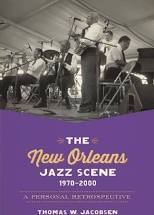Description
Release Year: 2014
Publisher: Louisiana State University Press
©LSU Press
Reviewed In OffBeat
David Kunian (February 2015 Issue)
Thomas Jacobsen is well qualified to assess New Orleans jazz in the last third of the last century. He wrote many articles for magazines including The Mississippi Rag, The Clarinet, and others.
He interviewed many musicians, both traditional and modern, for his Traditional New Orleans Jazz: Conversations with the Men Who Make the Music.
His latest book is a short survey of jazz in the Crescent City divided up by decade. Each chapter is divided up to sections on live music clubs, festivals, education, brass bands and musical luminaries.
In the first pages, Jacobsen states that he is an historian, not a musicologist, and this dictates his approach. This leads to an informative, yet very dry, means of providing the information. There are lots of dates and names, but few descriptions of the music or of what makes the New Orleans jazz scene fun or unique.
This is comprehensive, but it needed more anecdotes of conversations and live music to show readers the energy and whimsical, anything-goes informality of much of New Orleans music.
Where he excels is the recalling of some histories that have been glossed over such as the early, controversial history of Jazz Fest, the lack of development of Rampart Street, or the saga of Clarence “Buckwater” Washington.
He also gives recognition to some of the unsung pieces and people of the New Orleans music puzzle like the Norwegian Seaman’s Church, Don Marquis, Shirley Trusty Corey and several others.
This is a great reference book, but there are still several books that need to be written about this important and transitional period in New Orleans music.






